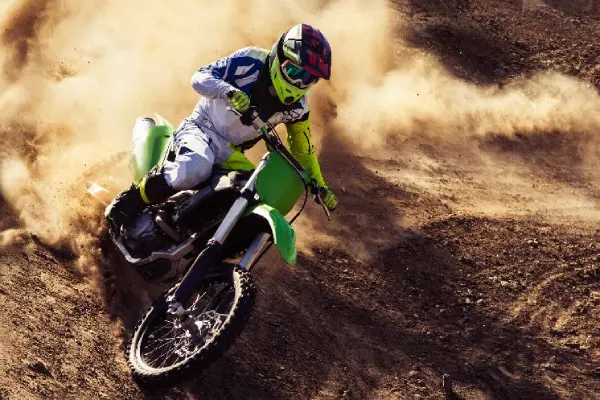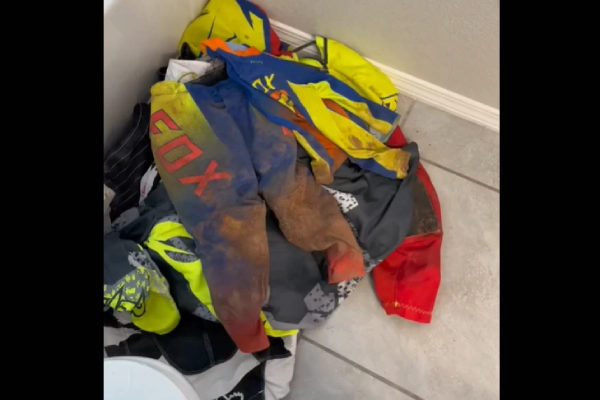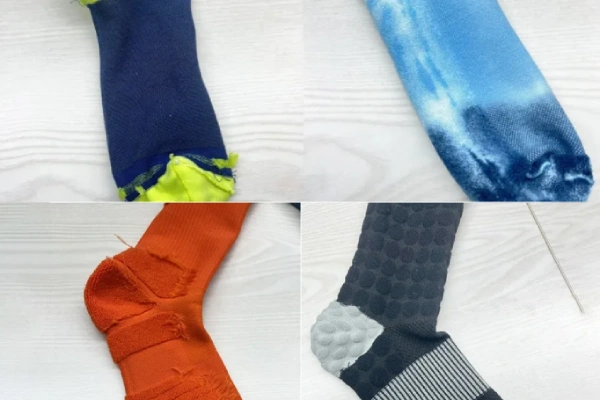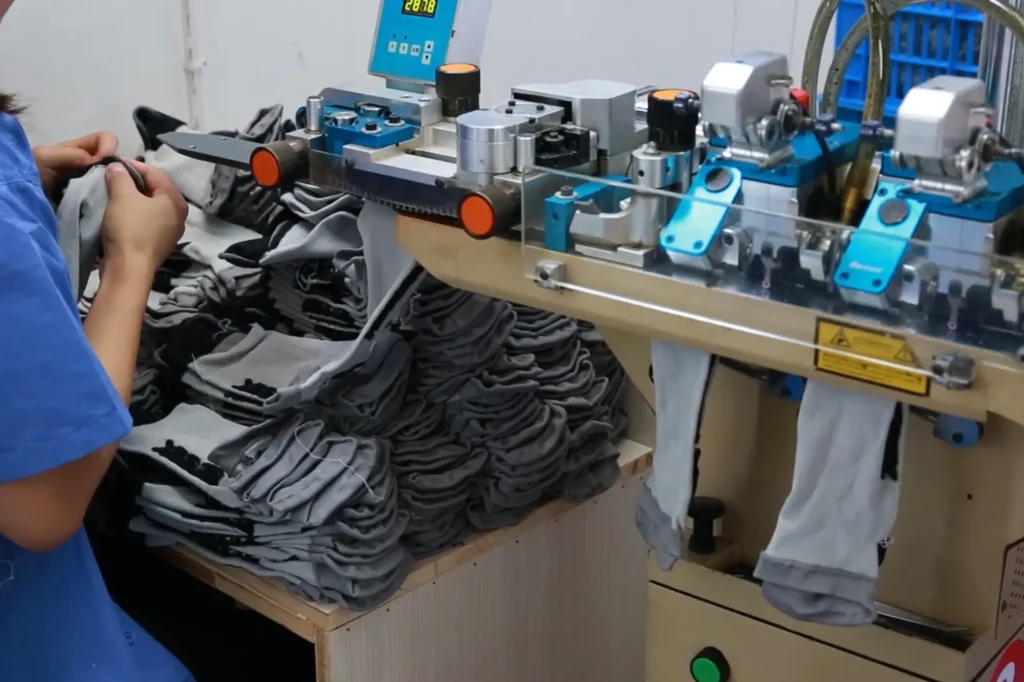Roost stings, boots run hot, ankles need to bend—often in the same lap. Zoned knitting is simply making the right areas protective, the bending regions flexible, and the sweaty areas breathable. This piece follows the problems riders actually face and shows how a purpose-built motocross sock design fixes them without turning your boots into a vise.
Roost hurts. Padding shouldn’t make boots tighter

Roost—gravel, clay, and track debris—targets the tibia exactly where your boot tongue and buckles load pressure. Thin, generic socks feel like sandpaper; thick carpet padding crowds the shell and shoves your shin forward.
A good sock treats the front of the leg as a cushioning zone that diffuses impact instead of piling thickness. The protective area follows the boot tongue and buckle footprint and tapers at the edges so there’s no ledge digging in. Less sting, no extra buckle notch, fit stays true.
On starts and when you tuck in behind the wheel, roost dulls to a thud rather than a sting. Buckle tension and tongue position stay consistent lap after lap, so the fit remains exactly where you set it.
Corners demand an ankle bend. Socks shouldn’t fight you

Aggressive cornering, quick shifts, and landings hinge on ankle travel. Stack thick material over the instep, and it folds as you dorsiflex—hot folds, rubbing, blisters.
The fix is a fine, low-density rib over the instep and ankle crease that moves with your foot, plus a supportive arch band that stops the sock from shearing inside the boot. You keep the peg feel and ankle travel—without hot folds.
Through whoops and rhythm sections, the instep flexes without forming a hot fold, keeping pressure even across the crease. Shifts register cleanly because the sock resists shearing inside the boot, so ankle travel stays free.
Boots run hot. Heat needs an exit

MX boots and knee guards protect well and vent poorly, so heat and sweat pool behind the calf and at the back of the knee. Trapped moisture makes everything slick and rash-prone.
That’s why a proper MX sock builds a posterior mesh back panel—a vertical vent chimney up the calf into the popliteal area. Under guards—or extended above the knee for brace socks—this channel gives warm, wet air a way out while the rest of the sock keeps structure. Between motos, you dry faster, and the next session doesn’t start with swampy calves.
During 15–20-minute breaks, the back of the leg dries quickly instead of staying clammy. With skin drier under guards or braces, liners stop skating around, and irritation subsides.
Stay-up without strangling
Sliding socks bunch under boot tops and straps; over-tight cuffs act like tourniquets. The sweet spot is a wide, pressure-spreading cuff that grips without biting. For over-knee versions, the hold should be evenly distributed so there’s security without hot spots. Outcome: no sliding, no mid-ride tugging, circulation intact.
A quick tell in plain terms: if you catch yourself pulling the sock up mid-session, the cuff is too narrow or too harsh. If you peel it off and a sharp groove lingers, it’s over-aggressive. The right cuff stays put without reminders and leaves only a faint imprint that fades within minutes.
Mud and miles: built to wash, built to last

Post-race mud washes and heat cycles can fade graphics, fuzz surfaces, and loosen support. The durable approach is reinforcement only where the boot abrades (heel, instep) and color/finish choices that resist mud stain and repeated cleaning. Aim for elastic recovery that holds shape and surfaces that avoid pilling so the sock still slides cleanly into the liner instead of grabbing.
Longevity checklist
- Heel still smooth, not fuzzy “drag paper,” after months of rides.
- Graphics/branding are readable after muddy weekends.
- Sock rebounds to shape after wash; no “stretched collar” look.
Picking thickness that plays nice with your boots

Treat thickness as a fit tool.
- Tight boots (new liners, race fit): choose thinner shin protection and a softer, lower-density instep to preserve space and ankle mobility.
- Roomier boots or riders who want more cushion on chattery terrain: use a mid-cushion front to fill volume and calm vibration.
- Mixed conditions (practice day to race day): keep two socks—thin race, mid-cushion practice—so your boot fit feels predictable across sessions.
The goal isn’t “thicker everywhere,” it’s support where it helps and freedom where you bend.
Knee braces, straps, and the back-of-knee problem

Turn the hinge into a smooth, vented runway
Knee braces solve one risk and create another: bulk and friction at the popliteal crease. Make that hinge glide, not grind, by using a continuous, low-friction fabric across the back of the knee—no raised joins, no hard transitions. Keep pressure calm with a wide, gentle thigh grip; distributed micro-grip holds better than a narrow, aggressive band and won’t leave a tourniquet line. Just as crucial, extend the posterior mesh back panel (“vent chimney”) above the knee so heat and moisture don’t bottleneck under the brace.
Layer once, ride quiet (order & quick checks)
Layering matters as much as fabric. Sock → brace/guard → pants. Set strap tension with the sock already on so the smooth surface sits next to skin and the liner stays planted. Quick checks:
- Deep knee bends & a few step-ups: the crease should feel slick, not scratchy.
- Thigh after peel-back: no sharp groove; adjust grip width/tension if you see one.
- After a 15–20 minute break, the back of the knee should feel noticeably drier; re-center the vent chimney if not.
- Ride start to finish: no creeping straps, no mid-session tugging.
Troubleshooting: symptoms → likely fix
- Shin bruised even with “padded” socks → Padding is too wide or square-edged; look for tapered protection aligned to the tongue footprint.
- Blisters across the instep → The “flex” area is too dense; choose fine rib over the crease and ensure the sock isn’t bunching under the strap.
- Heel rub / hot spots → Heel yarn too soft or surface too fuzzy; switch to smoother, tougher heel surfaces that still stay thin.
- Calf rash and sliding guards → No dedicated vent path; choose posterior mesh that runs up into the popliteal zone.
- Cuffs dig marks → Narrow, high-tension cuff; go wider and lower tension so pressure spreads.
Simple on-bench checks before you sign off.
You don’t need a lab to catch most issues:
- Tin-tap the shin — Wear the sock and tap the tibia with your knuckles or a plastic tire iron. You want sting turned to thud—impact diffusion without a ridge.
- Deep dorsiflex test — Pull the forefoot up hard 10–15 times. There shouldn’t be a biting fold over the instep; the rib should rebound smoothly.
- Heat-dump drill — After a short warm-up, take a 15–20-minute break. The back of the calf should feel noticeably drier if the vent chimney is working.
- Stay-up check — A few minutes of walking and light hops shouldn’t drag the cuff down; the arch should feel stable, not strangling.
Care that preserves performance

- Skip fabric softeners — they coat fibers and slow wicking.
- Inside-out wash, air-dry — protects surfaces, preserves elastic recovery, and any cuff grip.
- Shake out grit before washing — sand is sandpaper in a drum.
- Retire on time — if the heel slips heavily or the cuff no longer holds, you’ll feel it in boot slip and hot spots.
FAQ
Do motocross socks actually reduce shin pain from roost?
Yes — when the sock’s front-leg panel spreads impact and the edges taper instead of digging in, you feel a muted thud rather than a sharp sting. It works by matching the boot tongue footprint so the load is diverted more evenly.
Will ankle freedom suffer if the shin area is padded?
Not if the design keeps the instep/ankle crease area lighter and more flexible while concentrating padding on the shin. That way, you retain full mobility and control without compromising protection.
Why include a mesh back panel if boots are already ventilated poorly?
Because no matter how good the boot is, sweat and heat still build behind the calf and under guards; a posterior vent “chimney” gives that warm, damp air a path out so your calves dry faster and stay cooler between motos.
Are thicker motocross socks always better for comfort and protection?
Not necessarily — thickness helps only where it protects or cushions; too much everywhere can squeeze your fit, reduce feel on the pegs, or trap heat. Smart designs target padding where needed and keep flexibility elsewhere.
Do motocross socks stay up reliably during rides and under knee braces?
Yes — high-quality pairs use wider cuffs and distributed grip rather than tight elastic bands, so they stay in place without creating a tourniquet effect. For brace users, the thigh grip should spread pressure evenly and avoid slipping mid-session.

Max Hosiery — Where Zoned Knitting Meets Real Ride Comfort.
Start your next motocross socks project with our sample pack or OEM tech brief.
